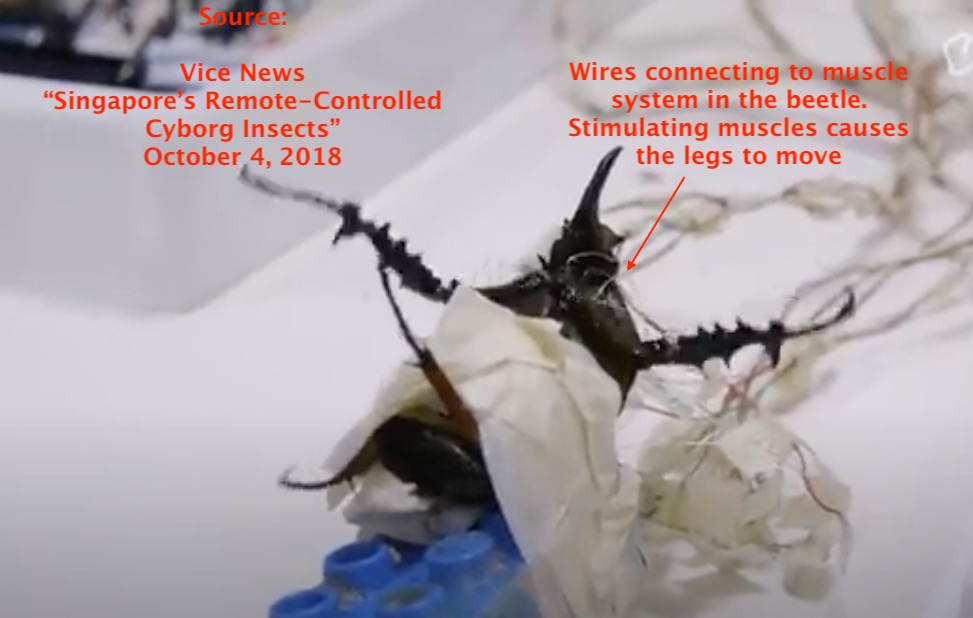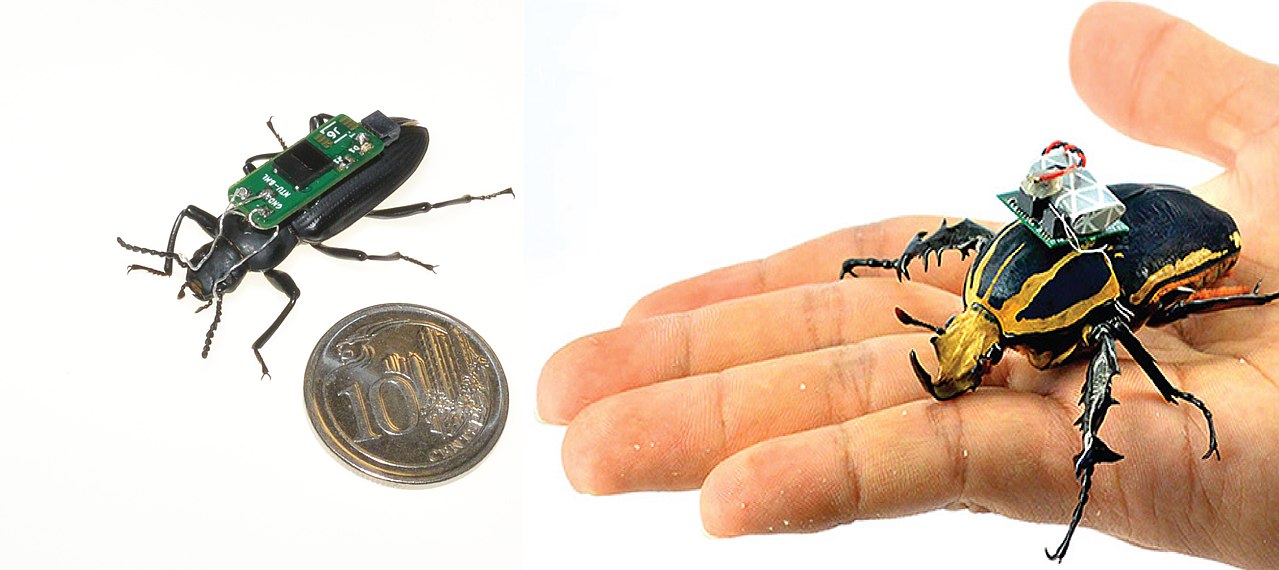; Date: Wed Oct 27 2021
Tags: Robotics »»»»
Scientists in Singapore have worked out the muscle structures in common beetles, and methods to electrically control the muscles using a computer. The result is a kind of robot made from a biological organism which can be remotely controlled to perform certain tasks. But, what of the free will of the controlled creature? But, what could go wrong on this slippery slope?

At the Nanyang Technical University in Singapore, Dr. Hirotaka Sato is researching how to cybernetically control beetles. It's curious that in the Vice News video, we clearly hear the presenter say Nanjing Technical University, but that university is in Nanjing China, and after much searching we found that Dr. Sato is with Nanyang Technical University in Singapore.
Dr. Sato has studied "many things" about the muscle configuration and the neural network of certain beetle species. He then worked out how to connect wires to the muscles, so he could inject electrical stimulus that causes the arms/legs of the beetle to move. With one species of beetle, he has created a radio receiver which can be attached to a beetle, that will relay signals to control its flight path by changing how it uses its wings.
On the one hand this is WOW and AMAZING that scientists have worked out how to do this.
On the other hand, why will they stop at insects, and what is the end goal of this? And what is the ethics of overriding the ability of a creature to control itself?
Attached below are three videos, the first by Vice News demonstrating the work by Dr. Sato. Another goes over several areas of cyborg insect development. The last is a DIY Howto video showing how to cybernetically/robotically control a Roach.
While looking into this, I learned of Hybrid Insect Micro-Electro-Mechanical Systems which was a research project funded by the Defense Advanced Research Projects Agency (DARPA) to develop cybernetically controlled insects. As near as I can tell, the HI-MEMS project is no longer active. But this research by Dr. Sato's team seems to be currently active, and it has similar goals to the HI-MEMS project.
The ethics of cybernetically controlled creatures
Watching the video of Dr. Sato's research I found myself in rage that they are overriding the ability of that animal to control its own body.
During the presentation we learned:
- The beetle was fighting back against being controlled
- The injected signals were causing the beetle's legs to move as directed, despite the beetle trying to fight back
- The beetle used its own food/energy to drive its muscles
In other words, I'm finding this to be on shaky ethical ground.
Every creature deserves to have its own control over its own body. This research seeks to override such control.
What is the state of the art in cybernetically controlled insects?
What we see in these videos is a very primitive technology which isn't ready for deployment as a productized thing. Installing the control circuitry is labor intensive, and the control circuit is very rudimentary.
In the first video showing Dr. Sato's team we see rudimentary control over the legs of one beetle, and rudimentary control over the wings of another. That video is from October 2018, or three years ago.
It's likely that advances have been made such that it's somewhat beyond the rudimentary stage shown here.
What is the potential for cybernetically controlled insects?
It's hard to imagine that the end goal of this research is control of insects. Instead, it's likely that insects were chosen because they are relatively simple creatures with relatively simple systems.
Why do I say the end goal is unlikely to be controlled insects? Insects have very little capabilities, and are easily crushed. It doesn't make sense to invest a lot into developing controlled creatures that can do very little and are easily destroyed.
In the video, Dr. Sato describes two goals. One is using insects in search and rescue missions, presumably because insects can easily infiltrate collapsed buildings. The other is some kind of terrorist hunting mission.
In both scenarios, isn't it important to be able to retrieve data from the controlled creature? For example, install on it a sensor package containing a camera, so that the cyborg insect could be sent in for reconnaissance missions and transmit information back to the controller. But, such a sensor package requires some weight which the insect might be incapable of carrying. But maybe there is a future microminiaturized circuit which could do the task?
What is the likely future direction for research into cybernetically controlled biology?
What seems more likely to me is graduating to larger and more capable creatures. The control system could also integrate more deeply with the creature.
For example, what about a cyborg dog? Dogs have an excellent sense of smell. What if a control package were integrated with the neurons in the dogs smell system, and could directly retrieve data about what the dog is smelling? This could be an excellent method for checking an area for harmful chemicals.
However, such a controlled dog would require a far higher level of control than is shown in the video of Dr. Sato's research. Dr. Sato's team can inject rudimentary control signals, but not receive information, nor have fine grained control over what the creature does.
One thing we learn is that Hybrid Insect Micro-Electro-Mechanical Systems (HI-MEMS) was (or still is?) a research project funded by the Defense Advanced Projects Research Agency (DARPA). The project was created in 2006 when DARPA asked scientists to submit "innovative proposals to develop technology to create insect cyborgs".
DARPA's goal was creating insects that could be controlled by humans, to be called Cybugs.
The idea was to create insects filled with circuitry, including GPS, to have the capability of remote control. One specific application is outfitting cybugs with chemical sensors, to send them into a building or cave to detect chemical traces including explosives.
The HI-MEMS was initiated by Dr. Amit Lal. An archive of the
DARPA page from 2007 is available on archive.org. Dr. Lal does not have any current research with DARPA, and nor does DARPA have current research about cyborg insects.
Instead,
Dr. Lal is currently a Professor at Cornell University. His bio does not mention any current research on cyborg insects. It describes how he had served as a program manager at DARPA from 2005-2009, and during that time he ran several programs in the area of navigation, low-energy computation, bio-robotics, and atomic microsystems. The "bio-robotics" area is where HI-MEMS fits.
It seems possible that DARPA has abandoned its plans to build an army of cyborg cockroaches. But this sounds like an exciting script for a science fiction book.

What about Dr. Sato at Nanyang Technical University?
His research is discussed at:
https://en.wikipedia.org/wiki/Remote_control_animal
Two papers are referenced there:
- Vo Doan, Tat Thang; Tan, Melvin Y.W.; Bui, Xuan Hien; Sato, Hirotaka (3 November 2017). "An Ultralightweight and Living Legged Robot". Soft Robotics. 5 (1): 17–23.
doi:10.1089/soro.2017.0038. ISSN 2169-5172. PMID 29412086.
- "
Controllable Cyborg Beetles for Swarming Search and Rescue". IEEE Spectrum: Technology, Engineering, and Science News. 28 November 2017. Retrieved 5 December 2017.
After much searching I found
we found a website for the Hirotaka Sato Group at Nanyang Technical University which describes ongoing research into cyborg insects.
For example, they announce a research paper
“Ultra-lightweight Cyborg Insect: Sideways walking of remote-controlled living beetle with a miniature backpack” is awarded Best Student Paper Award in 2019 IEEE RAS International Conference on Cyborg and Bionic Systems with this abstract:
Our paper abstract—Cyborg insect also referred as insect-machine hybrid robot or living legged robot consists of a living insect platform and an electronic backpack mounted on. The small size, insignificant load and magnificent walking ability of the insect make this hybrid system a strong candidate for search and rescue mission which requires high locomotory capabilities to cope with the complexity and unpredictability terrains and small size to access the debris of post-disaster sites. Such requirement drives the necessity to introduce more controllable mobility to the cyborg insects for developing efficient maneuver plans. Here, we demonstrate the control of sideways and forward walking in an ultra-lightweight terrestrial living legged robot by emulating the touch responses of echanoreceptors on the insect’s elytra using the electrical stimulation; the maximum velocity induced of the two motions is up to more than 30 mm/s. In addition, the elicited sideways and forward walking are found to be graded by tuning the frequency of electrical stimulation of the elytra that increasing the frequency will speed up the sideways locomotion and slow down the forward walking. Besides complementing the controllability of the cutting-edge living legged robots, such graded response provides the potential to precisely navigate the insect toward the development of highly-accurate-navigation cyborg insects for search and rescue.
This abstract still focuses on search and rescue missions, but doesn't give us an idea of the eventual goal.











